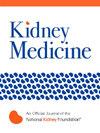Metabolomics to Identify Unclassified Uremic Toxins: A Comprehensive Literature Review
IF 3.2
Q1 UROLOGY & NEPHROLOGY
引用次数: 0
Abstract
A comprehensive review of known uremic retention molecules goes back to more than 10 years ago and did not consider metabolomic analyses. The present analysis searches for as of yet unclassified solutes retained in chronic kidney disease (CKD) by analyzing metabolites associated with relevant outcomes of CKD. This untargeted metabolomics-based approach is compared with a conventional targeted literature search. For the selected molecules, the literature was screened for arguments regarding toxic (harmful), beneficial, or neutral effects in experimental or clinical studies. Findings were independently crosschecked. In total, 103 molecules were selected. No literature on any effect was found for 55 substances, 3 molecules had no significant effect, and 13 others showed beneficial effects. For the remaining 32 compounds, we found at least one report of a toxic effect. Whereas 62.5% of the compounds with at least one study on a toxic effect was retrieved via the bottom-up approach, 69.2% of the substances originating from metabolomics-based approaches showed a beneficial effect. Our results suggest that untargeted metabolomics offer a more balanced view of uremic retention than the targeted approaches, with higher chances of revealing the beneficial potential of some of the metabolites.
代谢组学鉴定未分类尿毒症毒素:综合文献综述
对已知尿毒症滞留分子的全面回顾可以追溯到10多年前,并没有考虑代谢组学分析。本分析通过分析与CKD相关结果相关的代谢物,寻找慢性肾脏疾病(CKD)中保留的尚未分类的溶质。这种基于非靶向代谢组学的方法与传统的靶向文献检索进行了比较。对于选定的分子,在实验或临床研究中筛选了有关毒性(有害),有益或中性效应的文献。研究结果被独立地交叉核对。总共有103个分子被选中。55种物质没有发现任何作用的文献,3种分子没有显著作用,另外13种分子有有益作用。对于剩下的32种化合物,我们发现至少有一份毒性作用的报告。62.5%的至少有一项毒性效应研究的化合物是通过自下而上的方法检索到的,而69.2%的物质来自基于代谢组学的方法显示出有益的效果。我们的研究结果表明,与靶向方法相比,非靶向代谢组学提供了一种更平衡的尿毒症保留观点,更有可能揭示某些代谢物的有益潜力。
本文章由计算机程序翻译,如有差异,请以英文原文为准。
求助全文
约1分钟内获得全文
求助全文

 求助内容:
求助内容: 应助结果提醒方式:
应助结果提醒方式:


